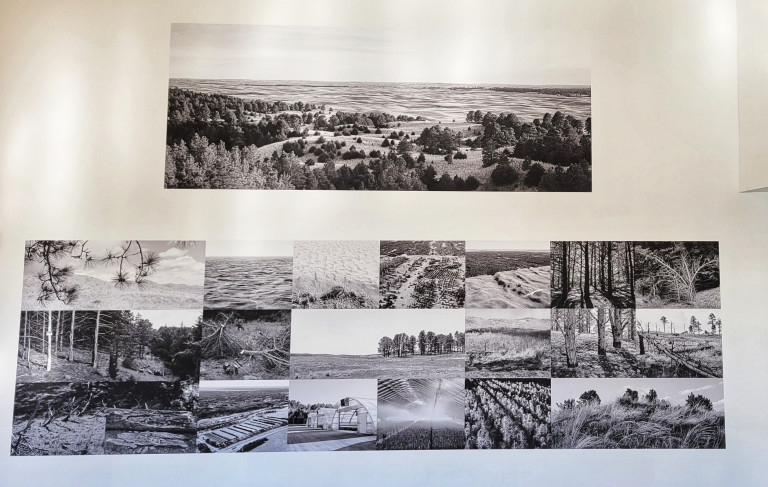Field Guide to a Hybrid Landscape

Field Guide to a Hybrid Landscape makes visible the forces that shaped what was once the world's largest hand-planted forest located in the Sandhills region of Nebraska, the largest intact temperate grassland in the world. Re:forest focuses on seedlings grown at Bessey Nursery, located in the Bessey Ranger District of the Nebraska National Forests and Grasslands. No longer producing seedlings for the hand-planted forest as originally intended, the oldest federal nursery now provides seedlings to National Forests with catastrophic fire and beetle damage.
Twenty-one smaller images of the forces shaping the hand-planted forest are installed under one large image from a high vantage point showing both forest and grasslands from the Scott Lookout Tower that was recently destroyed in a wildfire. Re:forest images installed in the windows include Bessey Nursery trees planted in the last twenty years interspersed with those of hands sorting, packing, and planting the seedlings.
Wind, water, planting, thinning, burning, decomposing, and sowing all contribute to its unique environmental history. A conifer forest was overlaid onto a semi-arid grassland just west of the 100th meridian in an ambitious late 19th century idea to create a timber industry, and to change the local climate. At that time, tree-planting was not considered in terms of carbon sequestration, but as a way to mitigate the wind and evaporation of moisture and to bring order to a disorderly landscape.
While the planners seemed not to appreciate the particular grassland ecosystem of the Nebraska Sandhills managed through grazing and fire until dispossession, they did recognize the reliable water from the Dismal and Middle Loup Rivers that bound the site. Later it was discovered that under all those grass-stabilized sand dunes was the massive Ogallala Aquifer that feeds the rivers through springs. This seemingly unlimited source of water below made it possible to plant a forest on the dry land above where the wave pattern on the riverbeds is mirrored in the larger scale sand dunes. In 1902, the first federal nursery was founded to produce trees for the new forest and for plains homesteads. That same year a forest reserve was officially established in the grasslands where 31 square miles of trees would be planted.
Historical fire suppression and misguided plantings, (some never taking hold, and others that have become invasive) present ongoing management challenges for foresters. While afforestation is no longer in practice at Nebraska National Forest, the on-site Bessey Nursery now grows replacement seedlings for burned and beetle-damaged National Forests in the Rocky Mountain region as well as the Nebraska Conservation Trees Program. This unique experiment of row-crop trees that were protected from the natural cycle of fire for decades, yet never commercially harvested for timber, provides a rich metaphor for our current environmental predicaments. This hybrid landscape has evolved from a turn of the 20th century effort to reclaim with trees what was called “The Great American Desert” to a focus on 21st century conservation, grassland restoration, and reforestation, all of which work to sequester carbon, maintain natural ecosystem balance, and mitigate large-scale climate change.
This exhibit was made possible in part through the support of the American Geophysical Union Voices for Science program.


